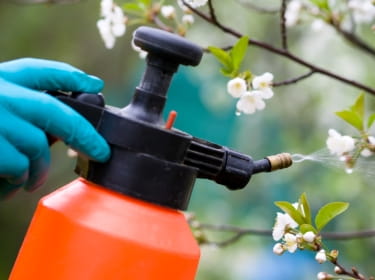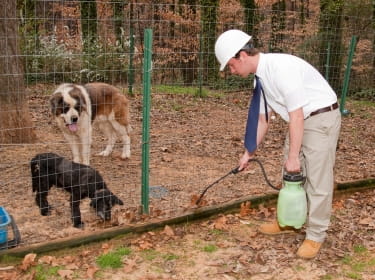Pesticide and Nerve Agents: Similar Poisons, Similar Symptoms

The Bottom Line
Organophosphate insecticides, sometimes used in and around the home, are related to some chemical warfare agents, specifically nerve agents. That fact drives home the point that insecticides must be chosen, used, and stored safely.

The Full Story
Some of the most common ingredients in pesticides are organic phosphorus compounds, also called organophosphates. Organophosphate pesticides are commonly used in and around homes, but related chemicals have been used as chemical warfare agents, specifically nerve agents.
A few of the chemical names of ingredients used in and around the home are malathion, diazinon, dichlorvos, fenthion, and chlorpyrifos. These are lower-toxicity pesticides used variously for home and garden pest control, veterinary treatments, agricultural pest control, and even treatment of head lice. Product labels contain detailed instructions for safe use:
- choose the correct product for the problem being treated;
- use the least amount that will do the job;
- handle with personal protective gear if indicated;
- avoid using products in an enclosed or unventilated space;
- discard them in an environmentally sound manner;
- keep children and pets away.
Of course, these products should be stored safely, in child-resistant containers and locked out of sight and reach of children and pets.
If organophosphate insecticides are misused, they can be absorbed into the body in a number of ways: by drinking, inhaling, or by skin absorption. The most dangerous effects are on the nervous system. There can be many symptoms, though they may not be as clear-cut in children as they are in adults:
- blurred vision;
- tearing and sweating;
- loss of bowel and bladder control;
- difficulty breathing, as the airway may fill with fluid;
- tremors, muscle twitching, and seizures;
- coma and even death.
Treatment should start with moving the person from the area, removing any contaminated clothing, showering for 15-20 minutes if pesticide is on the skin, and using webPOISONCONTROL®, the online tool for help from Poison Control, or calling Poison Control at 1-800-222-1222. Patients with symptoms can be treated with drugs called atropine and pralidoxime. Severe poisonings can be difficult to treat and recovery can be prolonged, making prevention of poisoning very important.
Organophosphorus nerve agents were discovered in Germany in the 1930s; tabun, sarin, and soman were produced during and after World War II. Great Britain developed a potent nerve agent called VX in the early 1950s. The most famous use of a nerve agent was by the Japanese cult Aum Shinrikyo. A 1994 release of sarin in Motsumoto resulted in seven deaths. A 1995 release of sarin in the Tokyo subway system resulted in twelve deaths and more than five thousand victims seeking medical attention.
Poison Control is on the front line of monitoring and assessing for any evidence that a chemical weapon release has occurred. While all medical records at Poison Control are confidential, symptoms that occur as a result of poisoning are assessed to determine if there is any indication of chemical weapons exposure. This assessment occurs in real time.
Should a chemical weapons attack be suspected or confirmed, poison specialists are familiar with the symptoms and treatment. They would advise individuals and health providers about treatment and work with health department officials to ensure the best possible outcome for victims.
Rose Ann Gould Soloway, RN, BSN, MSEd, DABAT emerita
Clinical Toxicologist
Poisoned?
Call 1-800-222-1222 or
Prevention Tips
All pesticides must be used carefully. Purchase the correct type, follow label directions exactly, and store them out of sight and reach of children (and pets).
This Really Happened
A 4-year-old girl drank malathion, an organophosphate pesticide. She was brought to a clinic after developing vomiting and diarrhea. She was also minimally responsive and struggling to breathe due to excess lung secretions, all toxic effects of this type of pesticide. She was given several doses of atropine (a drug that may help reverse the toxic effects of organophosphates) as well as pralidoxime (an antidote that may also reverse toxic effects of organophosphates) at maximum dosages and admitted to the hospital.
The child's symptoms worsened. Twelve hours after she presented, a breathing tube was inserted and she was placed on a ventilator. Her physicians continued to treat her with high doses of atropine and pralidoxime but two days later the child developed pulmonary edema (fluid build-up in the lungs) and continued to require a ventilator to breathe, as well as vasopressors (drugs that raise blood pressure when it is too low).
One of the child's physicians consulted the medical toxicologist at Poison Control to discuss the child's care and to ask how long the atropine and pralidoxime should be continued. The medical toxicologist explained that malathion can stay in fatty tissue such as the brain for up to 14 days and that there are case reports of needing to use these antidotes for up to 30 days.
Six days after the child ingested the malathion she remained on a ventilator with possible sepsis or pneumonia but had improved to the point that both the atropine and pralidoxime were discontinued. Eight days after she presented for medical care, she continued to need a ventilator to breathe, though her chest x-ray was improving. She had however developed ischemia (inadequate blood supply) of her small bowel and required surgery. The child remained in the hospital more than 2 weeks after drinking the malathion.
For More Information
Dowloadable infographic "Let's talk about pesticides in your home..."
References
Jett DA. Neurotoxic pesticides and neurologic effects. Neurol Clin. 2011;29:667–677.
Poisoned?
Call 1-800-222-1222 or
Prevention Tips
All pesticides must be used carefully. Purchase the correct type, follow label directions exactly, and store them out of sight and reach of children (and pets).
This Really Happened
A 4-year-old girl drank malathion, an organophosphate pesticide. She was brought to a clinic after developing vomiting and diarrhea. She was also minimally responsive and struggling to breathe due to excess lung secretions, all toxic effects of this type of pesticide. She was given several doses of atropine (a drug that may help reverse the toxic effects of organophosphates) as well as pralidoxime (an antidote that may also reverse toxic effects of organophosphates) at maximum dosages and admitted to the hospital.
The child's symptoms worsened. Twelve hours after she presented, a breathing tube was inserted and she was placed on a ventilator. Her physicians continued to treat her with high doses of atropine and pralidoxime but two days later the child developed pulmonary edema (fluid build-up in the lungs) and continued to require a ventilator to breathe, as well as vasopressors (drugs that raise blood pressure when it is too low).
One of the child's physicians consulted the medical toxicologist at Poison Control to discuss the child's care and to ask how long the atropine and pralidoxime should be continued. The medical toxicologist explained that malathion can stay in fatty tissue such as the brain for up to 14 days and that there are case reports of needing to use these antidotes for up to 30 days.
Six days after the child ingested the malathion she remained on a ventilator with possible sepsis or pneumonia but had improved to the point that both the atropine and pralidoxime were discontinued. Eight days after she presented for medical care, she continued to need a ventilator to breathe, though her chest x-ray was improving. She had however developed ischemia (inadequate blood supply) of her small bowel and required surgery. The child remained in the hospital more than 2 weeks after drinking the malathion.
